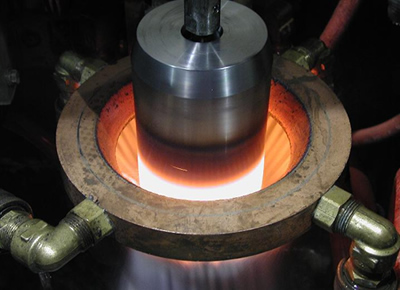Induction hardening uses induced heat and rapid cooling (quenching) to increase the hardness and durability of steel. Induction hardening is a method of quickly and selectively hardening the surface of a metal part. A copper coil carrying a significant level of alternating current is placed near (not touching) the part. Heat is generated at, and near the surface by eddy current and hysteresis losses. Quench, usually water-based with an addition such as a polymer, is directed at the part or it is submerged. This transforms the structure to martensite, which is much harder than the prior structure.
It is a no-contact process that quickly produces intense, localised, and controllable heat. Induction is being used to harden numerous components, such as gears, crankshafts, cylinder bars, drive shafts, output shafts, torsion bars, rocker arms, CV joints, tulips, valves, rock drills, slewing rings.
Typical Induction Hardening Materials

Typical materials include:
- 1045
- 4140
- 4340
- 4130
the benefits of induction hardening
- A fast and repeatable process that integrates easily into production lines
- Clean, safe, energy-efficient, and typically with a small footprint
- Individually treated workpieces; each piece is hardened to its precise specification
Increased Wear Resistance
There is a direct correlation between hardness and wear resistance. The wear resistance of a part increases significantly with induction hardening, assuming the initial state of the material was either annealed, or treated to a softer condition.
Increased Strength & Fatigue Life due to the Soft Core & Residual Compressive Stress at the Surface
The compressive stress (usually considered a positive attribute) is a result of the hardened structure near the surface occupying slightly more volume than the core and prior structure.
Parts may be Tempered after Induction Hardening to Adjust Hardness Level, as desired
As with any process producing a martensitic structure, tempering will lower hardness while decreasing brittleness.
Allows use of Low Cost Steels such as 1045
The most popular steel utilized for parts to be induction hardened is 1045. It is readily machinable, low cost, and due to a carbon content of 0.45% nominal, it may be induction hardened to 58 HRC +. It also has a relatively low risk of cracking during treatment. Other popular materials for this process are 4140, 4340。
DATONG HYDRAULIC are professional manufacturer of induction hardened rods and hard chrome rods. We have been supplying and exporting chrome rod and induction hardened rods for almost 20 years.
If you are interested in our Induction hardened chrome plated rod welcome to contact us via cally@datong-hydraulic.com
